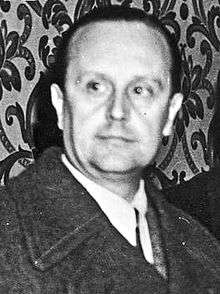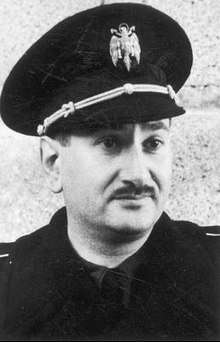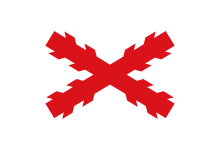Movimiento Nacional
The Movimiento Nacional (English: National Movement) was the name given to the nationalist inspired mechanism during Francoist rule in Spain, which purported to be the only channel of participation in Spanish public life.[1] It responded to a doctrine of corporatism in which only so-called "natural entities" could express themselves: families, municipalities and unions.
Composition
The Movimiento Nacional was primarily composed of:
- The sole legal party, called Falange Española Tradicionalista y de las Juntas de Ofensiva Nacional Sindicalista (FET y de las JONS) which had been created at the beginning of the Spanish Civil War. Other parties were prohibited (the sole name of "party" was prohibited to design any type of organization).
- The trade union organization, called Sindicato Vertical, composed of corporativist organizations which gathered employers and workers, in opposition to Marxism's class warfare.
- All civil servants and any holder of some sort of public office, they were requested to swear an oath to the Principles of the National Movement.
Leadership
The National Movement was led by Francisco Franco, titled Jefe del Movimiento (Chief of the Movement), assisted by a "General Minister-Secretary of the Movement". The hierarchy extended itself to all of the country, with a "local chief of the movement" named in each village.
Ideology
| Part of a series on |
| Falangism |
|---|
 |
|
Literature
|
|
Related topics |
| Politics portal |
| Part of a series on |
| Francoism |
|---|
.svg.png) |
People who strongly identified with the National Movement were colloquially known as Falangists or Azules (Blue), from the colour of the shirts worn by José Antonio Primo de Rivera's fascist organization created during the Second Spanish Republic. Camisas viejas (Old shirts) enjoyed the honour of being historical members of the Falange, compared to Camisas nuevas (New shirts), who could be accused of opportunism.
The ideology of the National Movement was resumed by the slogan ¡Una, Grande y Libre!, which stood for the indivisibility of the Spanish State and the refusal of any regionalism or decentralization, its imperial character, both past (the defunct Spanish Empire in the Americas, and foreseen in Africa), and its independence towards the purported "Judeo-masonic-Marxist international conspiracy" (a personal obsession of Franco), materialized by the Soviet Union, the European democracies, the United States (until the Pact of Madrid of 1953) or the "exterior enemy" which could threatened the nation at any time, as well as towards the long list of "internal enemies", like anti-Spanish, communists, separatists, liberals, Jews and Freemasons, among others, coining expressions like judeo-marxists.
Francoist "families"
Since one-party rule was enforced in Francoist Spain, the only way of pluralism consisted in internal "families" (Familias del Régimen) competing together inside the National Movement. These included the Catholic "family" (which brought the Roman Catholic Church's support and the national Catholicism ideology), the monarchist "family" (or conservative right, composed of many former members of the Spanish Confederation of Autonomous Rights), the traditionalist "family" (issued from Carlism), the military tendency (figures close to Franco himself, including the so-called africanistas) and the Azules themselves or national syndicalists, who controlled the bureaucracy of the so-called Movement: Falange, Sindicato Vertical and many others organizations, such as the veterans' national grouping (Agrupación Nacional de Excombatientes), the women's section (Sección Femenina), etc.
Franco held his power by balancing these internal rivalries, cautious not to show any favoritism to any of them nor compromise himself too much to anyone. Thus, all were united by a common interest, the continuation of Franco's defense of traditional Spanish society.
General Ministers-Secretaries of the Movement
| No. | Portrait | Name (Birth–Death) |
Term of office | ||
|---|---|---|---|---|---|
| 1 |  |
Raimundo Fernández-Cuesta (1896–1992) |
4 December 1937 | 9 August 1939 | |
| 2 | .jpg) |
Agustín Muñoz Grandes (1896–1970) |
9 August 1939 | 16 March 1940 | |
| 3 |  |
José Luis de Arrese (1905–1986) |
19 May 1941 | 20 July 1945 | |
| Vacant (20 July 1945–5 November 1948) | |||||
| (1) |  |
Raimundo Fernández-Cuesta (1896–1992) |
5 November 1948 | 15 February 1956 | |
| (3) |  |
José Luis de Arrese (1905–1986) |
15 February 1956 | 25 February 1957 | |
| 4 | .jpg) |
José Solís Ruiz (1913–1990) |
25 February 1957 | 29 October 1969 | |
| 5 |  |
Torcuato Fernández-Miranda (1915–1980) |
29 October 1969 | 3 January 1974 | |
| 6 |  |
José Utrera Molina (1926–2017) |
3 January 1974 | 11 March 1975 | |
| 7 |  |
Fernando Herrero Tejedor (1920–1975) |
11 March 1975 | 12 June 1975 | |
| (4) | .jpg) |
José Solís Ruiz (1913–1990) |
13 June 1975 | 11 December 1975 | |
| 8 | .jpg) |
Adolfo Suárez (1932–2014) |
12 December 1975 | 6 July 1976 | |
| 9 |  |
Ignacio García López (1924–2017) |
7 July 1976 | 13 April 1977 | |
Notes
- ↑ Payne, Stanley G. (2011-09-27). The Franco Regime, 1936–1975. University of Wisconsin Pres. p. 446. ISBN 9780299110734.
